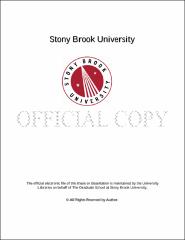| dc.identifier.uri | http://hdl.handle.net/11401/77430 | |
| dc.description.sponsorship | This work is sponsored by the Stony Brook University Graduate School in compliance with the requirements for completion of degree. | en_US |
| dc.format | Monograph | |
| dc.format.medium | Electronic Resource | en_US |
| dc.language.iso | en_US | |
| dc.publisher | The Graduate School, Stony Brook University: Stony Brook, NY. | |
| dc.type | Dissertation | |
| dcterms.abstract | My dissertation comprises the following three essays: the first essay analyzes third-price auctions, the second one considers patent licensing of an innovation with an unknown use; and the third essay studies the existence and uniqueness of Cournot equilibrium. Since the classic work of Vickrey (1961), the ranking of various auction forms in terms of expected revenue has been the central question of auction theory. When the bidders' information about the value of the object is independently and identically distributed, the so-called revenue equivalence principle provides a complete answer to the revenue ranking question. However, when the assumption of independence is relaxed, the answer is less well-understood. Utilizing the assumption that the bidders' information is affiliated, we analyze the third-price auction where the seller collects the third highest bid from the winner, and show that the third-price auctions performs better than the first- and second-price auctions. Although it has not been considered widely (or not at all) in the existing literature on patent licensing, licensing of a new technology could take place in environments where uses for it are, to some extent, unknown. That is, inventor holds the patent of a technology that could potentially reduce the costs of firms operating in a given industry, and some additional effort (or costly test) could discover its use with some positive probability. The inventor thus face the problem: should he first try to discover the use for the technology and then license it, or should he license the technology before a use has been discovered, leaving the discovery task to the licensees? This question has been raised in the second essay, and we show that the answer to this question depends on how discovery by each agent is related to discovery by other agents. The third essay studies the existence and uniqueness of Cournot equilibrium. Our conditions are weaker than the ones appearing in the literature, at the expense of multiple equilibrium points. However, we show that among these equilibrium points only one has a positive price. If we add the requirement that at least one firm produces at a positive cost whenever the industry aggregate output implies zero market price, then the equilibrium is unique and the equilibrium price is positive. | |
| dcterms.available | 2017-09-20T16:52:41Z | |
| dcterms.contributor | Brusco, Sandro | en_US |
| dcterms.contributor | Tauman, Yair | en_US |
| dcterms.contributor | Dubey, Pradeep | en_US |
| dcterms.contributor | Samet, Dov. | en_US |
| dcterms.creator | Tumendemberel, Biligbaatar | |
| dcterms.dateAccepted | 2017-09-20T16:52:41Z | |
| dcterms.dateSubmitted | 2017-09-20T16:52:41Z | |
| dcterms.description | Department of Economics. | en_US |
| dcterms.extent | 56 pg. | en_US |
| dcterms.format | Application/PDF | en_US |
| dcterms.format | Monograph | |
| dcterms.identifier | http://hdl.handle.net/11401/77430 | |
| dcterms.issued | 2015-08-01 | |
| dcterms.language | en_US | |
| dcterms.provenance | Made available in DSpace on 2017-09-20T16:52:41Z (GMT). No. of bitstreams: 1
Tumendemberel_grad.sunysb_0771E_12099.pdf: 445518 bytes, checksum: 1e9c475160813499a0ed320dacedec99 (MD5)
Previous issue date: 2014 | en |
| dcterms.publisher | The Graduate School, Stony Brook University: Stony Brook, NY. | |
| dcterms.subject | Economic theory | |
| dcterms.title | Essays in Game Theory and Its Applications | |
| dcterms.type | Dissertation | |

